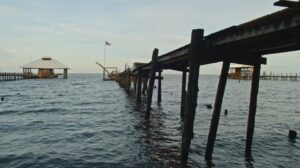Troll Wall, in Norway’s Trolltindene massif, is the tallest and one of the most dangerous rock faces in Europe. The danger doesn’t come from difficulty, steepness, or height. It comes from the rock itself. The rock is loose.
At any given moment, sheets of rock, some the size of shipping containers, crash down the face into the rubble below. In 1965, two teams, one British and one Norwegian, raced to make its first ascent. The Norwegians won, with the British just one day behind.
Since then, the wall has seen a number of successes, failures, and deaths. Last July, Pete Whittaker and Mari Augusta Salvesen decided to make the latest attempt on the Troll Wall. They had tried once before but bailed before they started because the conditions were too dangerous.
A giant piece of rock crashed down the Wall
On this second attempt, the duo wanted to climb the Norwegian route in 24 hours. They completed the first nine pitches in seven hours. With every pitch, they heard two or three rockfalls happening somewhere else on the wall. The worst occurred at pitch four. A loud cracking noise came from the back of the valley, just 400m away. A truck-sized piece of rock dislodged from the steepest section of the rock face and crashed down the wall. Both climbers said that it felt like the wall was crumbling around them.
As they speak into the camera after this, you can hear the nerves creeping into their voices. The danger of the wall is clearer than ever. Still, they continue and manage to make the halfway point in 12 hours.
Over 27 hours and 20 minutes, they creep their way to the top of the 1,000m wall in 30 pitches. They are glad that they chose the Norwegian route since they wouldn’t have felt comfortable climbing further to the right without more local knowledge and experience.
Though the wall is famous for its rockfall, the two were surprised at how often it happened during their climb. “It is not a wall to be taken lightly, that’s for sure,” said a relieved Whittaker after it was over.






